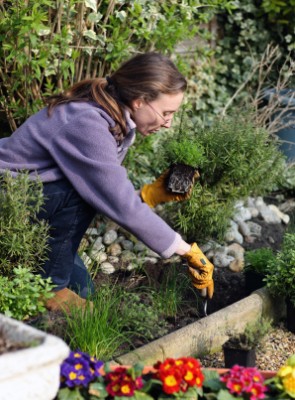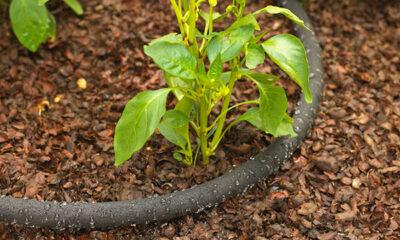We’ve had gardening as part of our emergency preparedness plans for years, but it wasn’t until a couple of years ago that I decided to start gardening ahead of time, before a disaster struck. To be honest with you, I’m not a natural gardener. In fact, where some people are known for having a green thumb, I’m known for having a brown one. Nevertheless, we decided to garden.
One of the problems I have with gardening is that I’m not good at the mundane tasks of watering and weeding. I’ve got too many other things on my plate, so I try to avoid doing anything extra. Coupled to that is my background as a manufacturing engineer. I just plain like things that work by themselves, rather than things that I have to constantly take care of. So, that’s what I wanted for my garden, as well.
The Best Source For Non-GMO Heirloom Seeds Is Right Here!
While it may not be possible to fully automate a home garden, there are a number of things which can be done to make it at least somewhat self-sufficient. I’m not talking about hydroponics or aquaponics or any other exotic system here, I’m talking about regular gardening. You’ll see.
Automated Watering
To me, there’s no real reason to have a vegetable garden that doesn’t include automated watering. So, the first thing to automate in any garden is the watering. There are three basic types of systems to choose from, one which I feel is wasteful, but either one of which will provide adequate water, efficiently.
- Soaker Hoses – Soaker hoses are underground watering systems which use a porous hose to bring water directly to the roots of the plants. This is excellent in hot climates, as less of the water ends up evaporating and more of it ends up being used by the plants. A soaker hose system can run as much as 100 feet at one time. We run two lengths of hose down each raised bed, so we can only put 50 feet of soaker hoses or 50 feet of planters on each valve.
- Drippers – Drippers allow you to give the water to each individual plant, right at the base of the plant. This prevents waste by making sure the water only goes where it is needed. The problem with soakers, as far as I’m concerned, is that they have to be set up again, every time you change your garden. If you rotate your garden, this means a lot of set-up time. However, I have to say that drippers are excellent for potted plants, such as plants on your patio or the pots you may have for a vertical garden. In fact, drippers are the only system I would use with a vertical garden system.
- Sprinklers – The more traditional means of providing automated watering is with sprinklers. I don’t recommend these, simply because sprinklers will waste a lot more water than any other system. Not only do you waste water that is sprayed outside of the garden’s perimeter, but you also lose a fair amount of water to evaporation, before it can even get into the ground. On the other hand, sprinklers are much easier to set up than drippers, but not easier than soaker hoses.
Automating the System
Turning these watering systems into an automated watering system requires adding in a timer. The typical timer is capable of operating up to four valves, allowing you four separate watering zones. That way, you can water more area than the limits posed by the watering system you choose. In other words, you could have several zones of soaker hoses, each of which has 100 feet of hose.
By the way, you only use the soaker hose in the garden or around trees. The space between planter beds or getting to the garden is done with a solid hose that doesn’t leak water. That helps add to the efficiency of the system.
Fertilizing Automatically
 With the watering system in and watering your garden automatically, you’re ready to move on to the next step of automating your garden. That’s to fertilize automatically. There are two ways of doing this:
With the watering system in and watering your garden automatically, you’re ready to move on to the next step of automating your garden. That’s to fertilize automatically. There are two ways of doing this:
- Mix the fertilizer into the water that is going to be used to water the garden
- Use an injector to inject fertilizer into the water stream going to the garden
Mixing the fertilizer into the water requires a large tank to be used as your supply tank for the garden. You also eliminate the ability to use that water for other purposes, as it will have fertilizer mixed in. However, it provides a consistent way of fertilizing.
New Natural Fertilizer Doubles Garden Production!
Using an injector is actually more automatic, in my opinion. We’ve got an injector installed permanently in our watering system, just before the automatic timer and its valves. It has its own valve, so that we can turn it on and off when we want. That way, we aren’t over-fertilizing our garden.
The Fertilizer
There are many different fertilizers you can use with a garden, but I find that a fish effluent is the best. You can buy this or make it yourself from scrap fish. Whenever you are cleaning fish or eating it, save all the scraps, putting them in a sealed container in the freezer. Then, when you need to make the fertilizer, follow these steps:
- Thaw the fish parts and run them through a blender to chop them fine. We have an old blender we use just for this, so that I don’t mess up my wife’s good one.
- Add water to the chopped up fish at a ratio of 1:1. Some people say 1 part water to 2 parts fish, but I find that the 1:1 ratio works fine.
- Put it in a sealed container and set it in the sun, away from your home.
- Mix the effluent once every three days, by lightly shaking the container and turning it over a couple of times.
- The effluent should be ready for use in about a month.
If your effluent ends up chunky, you didn’t blend it enough. You can blend it again to remove any chunkiness. Otherwise, it is likely to plug up the injector.
Use Insects to Your Advantage
Another way to automate your garden is to use insects and even birds to your advantage. We bought a bunch of ladybugs for our garden, because they are carnivorous and help keep down the caterpillar population. Likewise, we have placed a bird bath and bird feeder in our front yard. This invites birds to come and eat, who also sit on our hedge and eat any convenient caterpillars they find chomping on the leaves.
Worms are another important part of keeping your garden healthy. A good worm population helps to break down the compost in the earth, making the nutrients available to the plants.
Don’t Forget the Fungi
One last thing I’d like to mention: the use of mychorrhizal fungi. These fungi form a symbiotic relationship with the plants’ roots, extending the roots of the plants and bringing nutrients and water to them. A garden with mychorrhizal fungi in it will grow larger, healthier plants, which in turn provide for a larger harvest.
These fungi are probably the easiest and most automatic thing you can do for your garden. Simply sprinkle some of the fungi in the garden and leave them alone. They’ll take it from there. Within days, you’ll be able to see the fungi attached to the roots of plants, doing their job.
One precaution when using mychorrhizal fungi: Don’t till your garden every year. That will break up the fungi, killing a lot of it. Just remove the dead plants and compost them. Then top your garden with compost for the winter. In the spring, you’ll be ready to start planting, without having to till the soil.
What other suggestions would you add for planting an automated garden? Share your thoughts in the section below:
Every Year Gardeners Make This Avoidable Mistake — But You Don’t Have To. Read More Here.
 Off The Grid News Better Ideas For Off The Grid Living
Off The Grid News Better Ideas For Off The Grid Living





